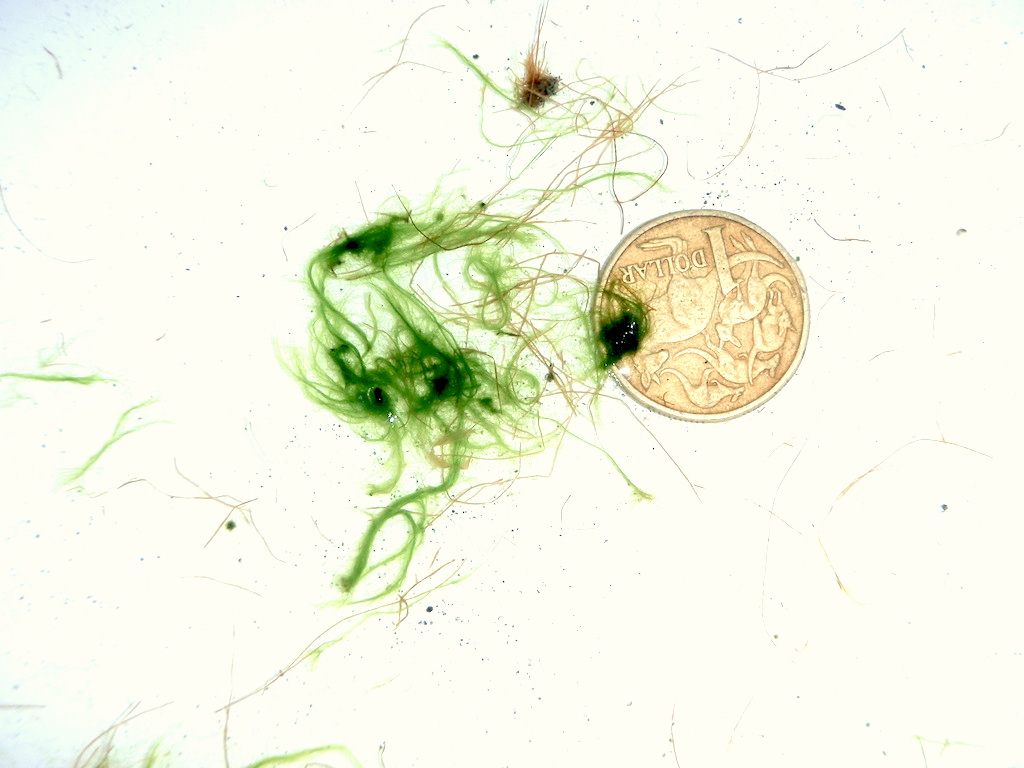This species forms bright green rope-like strands (Image A), which can incorporate other species (the featured image above is a carpet formed with Urospora neglecta (Kornmann) Lokhorst & Trask). The individual filaments are uniseriate, unbranched and curved (Image B). Vegetative cells are squat to elongate with a barrel shape, 22-38 µm wide by 28-69 µm tall (Image C). The zoidangia (gametangia?) are typically isodiametric to elongate, 36-49 µm wide by 42-65 µm tall (Image D), with a slight barrel shape, but can become longer by apparently adjacent structures fusing internally (Image E).
Although there are actually no Canadian records to date, this species needs to be presented to facilitate further exploration of the chaotic taxonomy of this group in northern waters. There are three collections; one is based on morphology (GWS041865Extra; discussed below) while the other two are genetically linked one each from Nome, AK, and the other from Norway. This suggests a pan-(sub)Arctic distribution likely extending into colder waters of all three Canadian coasts. Considerably more collections are necessary to better understand the morphological, ecological and biogeographical distribution of this genetic group. All three collections are from upper intertidal on rock in pools or exposed.
This species is a smaller version of Urospora bangioides (Harvey) Holmes & Batters, with which it is very closely allied in tufA sequence, these sister to Urospora wormskioldii (Mertens ex Hornemann) Rosenvinge. The latter two and the allied Urospora sp. 2Nome, as well as Urospora neglecta (Kornmann) Lokhorst & Trask fail to join Urospora speciosa (Carmichael) Leblond ex Hamel and the type Urospora penicilliformis (Roth) Areschoug in our preliminary phylogenetic analyses. Taxonomic work is needed.
It is common for what otherwise looks like a unialgal carpet on rock, or mat of green filaments in an estuary, to be a chaotic mix of green species including, among others, various Blidingia spp., Percursaria percursa (C.Agardh) Rosenvinge, Rosenvingiella polyrhiza (Rosenvinge) P.C.Silva, Urospora spp. and Ulothrix spp. Identification should be done carefully, as should attempting to match DNA sequences to individual species. Owing to the wonders of PCR, a clean sequence could be from any one of the species present in a collection and not necessarily the dominant one on which the microscopical identification was based. Consequently, I am not yet 100% certain that the genetic groups and morphospecies completely align for the various Urospora spp. presented on this site. This is my best guess after consulting the pertinent literature (mostly Scagel (1966), Burrows (1991), Sears (2002), Brodie et al. (2007), Mathieson & Dawes (2017) and Gabrielson & Lindstrom (2018)). Considerable work remains for this genus in our flora. In this case the morphological evidence provided for GWS041865Extra is not from a genetically verified collection, but from filaments tangled from verified(?) Urospora neglecta (Kornmann) Lokhorst & Trask.

Image A. The uniseriate filaments form rope-like strands, which in our limited collections can incorporate other filamentous green species, notably Urospora neglecta (Kornmann) Lokhorst & Trask (upper intertidal on rock, Nome breakwater at the Beach, Nome, AK; GWS042597).

Image B. Closer view of the curved uniseriate filaments forming rope-like strands (GWS041865Extra).

Image C. Vegetative cells are squat to elongate with a slight barrel shape (GWS041865Extra).

Image D. Zoidangia are squat to elongate with a slight barrel shape (GWS041865Extra).

Image E. Individual zoidangia appear to be fusing within the filaments to make larger structures (GWS041865Extra).
